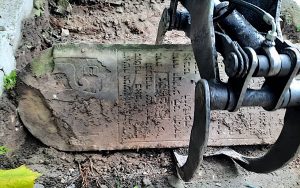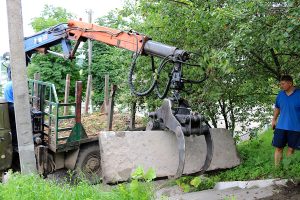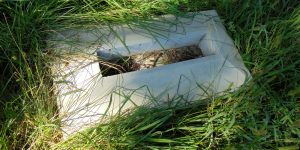![]() Ця сторінка також доступна українською.
Ця сторінка також доступна українською.
Introduction
This page summarizes and analyzes a two-phase project which first extracted and collected displaced Jewish headstones in the village of Zaliztsi in the Zboriv raion of the Ternopil oblast in western Ukraine, and transported them for safekeeping to the Jewish cemetery in the village. In the second phase, the headstones were set upright in concrete bases to serve as a memorial monument to the named dead on the stones and to the lost Jewish community of the village. This project coordinated efforts by the local village council, the area’s museum of local history, heritage activists of the regional Jewish community, a scholar of regional Jewish culture, local citizens, plus history- and heritage-focused journalists in the region.
This page is intended as a reference for similar projects now in the planning stages in western Ukraine or beyond. Following a brief summary of the site, the material below describes the project and reviews its effectiveness together with a listing of issues encountered, approximate project costs, and ongoing risks. Related projects both in western Ukraine and elsewhere in Europe are also briefly mentioned, for comparison. At the bottom of this page are links to project documentation and to additional reference information about the burial site and related projects.
Read the overview to case studies of selected projects at Jewish burial sites in western Ukraine.
Project Summary
Project type: Identification, recovery, and return of Jewish headstone fragments which were taken from a Jewish cemetery during and/or after WWII and misused as building materials in the area. Resetting of the recovered headstones as a memorial monument on the cemetery site.
Location and site type: Jewish cemetery of Zaliztsi, Zboriv raion, Ternopil oblast, Ukraine. GPS: 49.79203, 25.38015. Two headstone recovery sites in Zaliztsi: in the threshold in front of a Soviet-era public toilet adjacent to the new local history museum (GPS: 49.80194, 25.38124), and in the steps and walkway leading to a polyclinic (GPS: 49.80219, 25.38096).
Description of the site: The cemetery perimeter is a notched near-rectangular shape of approximately 380m length, enclosing roughly 0.75 hectare of area, on a hillside with moderate slope.
Ownership and stakeholders: The cemetery site is owned by the municipality of Zaliztsi. Stakeholders include the local civil community, foreign descendants of Zaliztsi pre-war Jewish and other families, historians, and students of Jewish culture.
Official heritage status: Unknown.
Activists working on/at the site: Vasyl Ilchyshyn, director of the Zaliztsi Museum of Local Lore; the executive committee of Zaliztsi village council, including its chairman Liubomyr Fesyk and many others; Israel Meir Gabbai, director of Oholei Tzadikim, a non-profit organization based in Jerusalem, Israel; Tetiana Fedoriv, a scholar of regional history and heritage with specialization in Jewish culture; plus other local and regional activists including Hryhoriy Arshynov, Serhiy Martsinko, and Olha Shevchuk. Contact info for the organizations is available in the links above.
Other projects active at the site: Digital documentation of the cemetery terrain (see ESJF 2019 survey project); perimeter steel fencing was installed sometime after 2000, and a masonry closed ohel was constructed after 2000 as well. The site has been regularly cleared for at least two decades.
Project Analysis
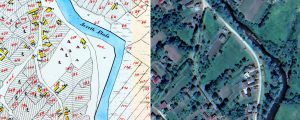
The Jewish cemetery of Zaliztsi on an 1850 cadastral map and on a modern satellite image.
Map courtesy of TsDIAL and Gesher Galicia; satellite imagery © CNES/Airbus, Maxar Technologies, and Google.
History of the site: According to the Encyclopedia of Jewish Communities of Poland, Jews were recorded in Zaliztsi at least since the early 17th century. The Jewish community numbered in the hundreds in the 18th century, and Austrian imperial censuses from 1880 and 1900 show more than 2000 Jews in the village, making up roughly a third of the total population. The year in which the cemetery was established is not recorded but is likely in the 18th century; the cemetery appears at roughly current size and shape on an Austrian cadastral survey map from 1850. The Jewish community significantly collapsed during World War I, dropping in number (to several hundred) and proportion (to roughly 10% of the Zaliztsi total). The community population stabilized during the interwar period; a 1929 business directory lists more than 200 individual Jewish merchants and professionals. During the German occupation of World War II, no ghetto was established in Zaliztsi; except for individuals held for forced labor on roads and food supply, the entire Jewish community was transported to the Zboriv ghetto and then destroyed. Under later Soviet rule, headstones from the Jewish cemetery were used for official and private building projects in Zaliztsi; some headstone fragments have been returned to the cemetery by Zaliztsi residents in the past several decades.

The broken gate, and two collections of headstone fragments inside the cemetery fence. Photos © RJH.
Current features of/at the site: Since the Soviet era the cemetery has been devoid of headstones standing in their original places. The site fronts a road with a gate through a visually open steel picket fence, and extends as an open grassy field across a mild to moderate slope to the far (southwest) end, which also borders a small road. A large closed masonry ohel stands near the middle of the cemetery’s northwest boundary; according to a sign it covers the graves of two esteemed religious leaders buried there in the early 19th century. A few stands of large trees provide a small amount of shade. Photographs from several visits over the first decades of the 21st century show the site has been generally well maintained, with some wild grass cleared from time to time and recurring but not overwhelming invasive plants. A large number of Jewish headstone fragments are piled at the low (northeast) front end of the cemetery, and several other fragments are scattered around the low end as well. The fence is significantly decayed, with several displaced panels and the gate broken.
Details of the project: As part of a larger program of local heritage rehabilitation and preservation undertaken by the Zaliztsi village council, local historians, and heritage leaders, an effort was begun to recover Jewish headstones known to be present in steps and walkways in the village. Hryhoriy Arshynov, a Jewish heritage activist working across Ukraine provided initial funding for the extraction of the headstones and connected the representatives of the village council and the local history museum with Jewish community leaders working in the region for advice, assistance, and coordination of resources. In June 2020, headstones discovered during works at the new museum site were extracted by hand; then in July, the large number of headstones at the polyclinic site were extracted by hand and by heavy machinery managed by the village. The machinery was then used to load the headstones onto a large truck, which brought the headstones onto the Jewish cemetery grounds, where they were unloaded and spread out near the front of the cemetery for cleaning, evaluation, and planning. A specialist in headstone documentation and translation (see case study 04) was brought to the site to inspect, photograph, and document each stone. Finally, in September 2020 forms were built for several concrete pads in two rows near the front of the cemetery, the stones were again lifted by heavy machinery and set upright within the forms, and concrete was poured to fix the headstones in place, making a memorial monument and focal point for the cemetery. In all, 23 intact and broken complete headstones were recovered together with 4 fragments; all 27 stones were set erect on the cemetery grounds.
Issues encountered in the project: Removal of the headstones from the steps and walkway at the polyclinic necessitated replacement with suitable materials, which needed to be arranged in advance so that access was interrupted for only a short time. Otherwise no issues were encountered in the work; cooperation between the various activists and authorities who worked on extracting and resetting the headstones was excellent.

Extracting, loading, and unloading headstones by hand and with machines. Photos © Zaliztsi village council and Vasyl Ilchyshyn.
Project costs, one-time and sustaining: Most of the labor for extracting, transporting, and setting the headstones was volunteer, or furnished by the Zaliztsi village council as part of their ongoing heritage conservation effort. All costs not donated by volunteers or supported by the Zaliztsi village council were funded by Hryhoriy Arshynov and by Oholei Tzadikim, including the heavy equipment which assisted the headstone recovery and transportation, reworking the steps at the polyclinic with new materials substituted for the extracted headstones, and the concrete and forms for resetting the headstones in the cemetery. Cost information for this project is not currently available from Oholei Tzadikim. Sustaining costs for the memorial are expected to be very low, limited to occasional maintenance and cleaning.

Assembly and finishing of the memorial in the Zaliztsi Jewish cemetery in September 2020. Photos © Vasyl Ilchyshyn.
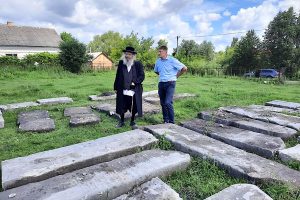
Rabbi Gabbai with the Zaliztsi council chairman among the recovered matzevot. Photo © Vasyl Ilchyshyn.
Current risks to preservation: One small issue at the Zaliztsi cemetery site would perhaps actually be welcome: the high likelihood that more Jewish headstones will be discovered scattered around the village, and extracted for recovery and return to the cemetery. Then the issue would be how to extend the existing memorial to incorporate the new stones, although the memorial design and the cemetery size could certainly accommodate many more recovered matzevot. The size of the Zaliztsi Jewish community recorded in historical censuses and the age of the cemetery together suggest that there should be many hundreds if not thousands of headstones embedded under streets and sidewalks and in the foundations of residential and service buildings built during the Soviet era, as this was a common practice in western Ukraine from WWII and for decades later.
The mechanical and chemical compatibility of Portland concrete and natural stone is a persistent concern among stone conservators and monument designers. Although there are a number of memorial monuments in western Ukraine and beyond which cast entire Jewish headstones (or encase fragments) carved from limestone and other natural stone types in beds or walls of concrete, there are serious long-term damage risks: expansion and contraction of the dissimilar materials, the softness of natural stone vs. the hardness of Portland concrete, soluble salts driven into stone as the concrete cures, and the difficulty of reworking or reversing concrete installations. Safer alternatives exist, though they require more time and effort; most involve lime mortars as the fixing material, though traditional deep ground support for standing stones is still feasible in some cases. Time will tell whether there is any actual risk to the headstones at the Zaliztsi cemetery memorial. See the guide page to stone conservation on this website for more information.
Related projects in western Ukraine: Jewish headstone recovery projects in western Ukraine are summarized in case study 07 (around Rohatyn in Ivano-Frankivsk oblast) and case study 13 (from a street in Lviv) on this website. One example of a memorial incorporating recovered standing Jewish headstones is summarized in case study 09 (near Rudky in Lviv oblast); another example which embeds headstones and fragments in a concrete memorial wall is at the Jewish cemetery of Dobromil (Lviv oblast). A project organized by HFPJC (Avoyseinu) at the Jewish cemetery of Rozdil (also in Lviv oblast) repaired and reset fallen headstones in a large number of new poured concrete bases quite similar to those in Zaliztsi; the HFPJC site report includes helpful photographs of the work in progress to re-erect and set the headstones.
Related projects outside western Ukraine: A massive Holocaust memorial in the new Jewish cemetery of Kazimierz Dolny near Lublin in Poland uses recovered headstone fragments in a high concrete lapidarium wall with a wide and jagged cast crack symbolizing the tragic break in history; other headstones with intact bases have been reset upright in the cemetery grounds nearby. In the Polish town of Oświęcim, less than 4km from the notorious Auschwitz concentration camp, the Jewish cemetery was stripped of its headstones during the German occupation of WWII; after the war, Jewish survivors substantially reconstructed the cemetery using recovered headstones embedded into the soil, with some fragments incorporated into a sculpted memorial. In 2016, local and foreign volunteers working with the Polish Jewish community set 25 additional recovered headstones into precast concrete bases, lining the stones with gravel around at their lower ends to support the stones without binding in the bases.
References
- Facebook post dated 26Jun2020 – on the discovery and extraction of Jewish headstones in the threshold of a Soviet-era public toilet, posted by the Zaliztsi Museum of Local Lore
- Впорядкування об’єктів культурної спадщини (Management of cultural heritage sites) – news article dated 06July2020 about the discovery and recovery of Jewish headstones from the steps of a polyclinic building, on the website of the Zaliztsi village council
- Сходи та поріг туалету зробили з… надгробних плит: у Залізцях повертають на місце мацеви з єврейського кладовища (The stairs and the threshold of the toilet are made of… tombstones: in Zaliztsi, matzevot from the Jewish cemetery are returned to the place) – news article dated 08Jul2020 by Iryna Nebesna about the recovery of the matzevot in Zaliztsi, on the Ternopil-based web news site Terminovo
- Facebook post dated 10Jul2020 – with a drone-view video of the recovered headstones at the Zaliztsi Jewish cemetery, posted by activist Hryhoriy Arshynov
- Facebook post dated 14Sep2020 – on the resetting of recovered headstones in the Zaliztsi Jewish cemetery and completion of the project, posted by Vasyl Ilchyshyn, director of the Zaliztsi Museum of Local Lore
- Zaliztsi Jewish Cemetery – terrain measurements and survey notes by ESJF European Jewish Cemeteries Initiative
- Załośce Town Center Cadastral Map 1850 – a highly detailed historical property map of the town from a survey during the Austrian era, showing the Jewish cemetery and many other town features, from map panels preserved by the Central State Historical Archive in Lviv (TsDIAL) and presented by Gesher Galicia
- Zalosce – an online English translation of Pinkas Hakehillot Polin (Encyclopedia of Jewish Communities, Poland), Volume II, pages 193-195, published by Yad Vashem; translation coordinated by Jim Stein, hosted by JewishGen on the website for their Yizkor Book Project
- Zalosce 1929 Business Directory – a transcription and translation on the JewishGen KehilaLinks page for Zalosce, Ukraine; original directory page image archived on a JewishGen/JRI-Poland records project website and indexed on Genealogy Indexer
- From Medzhybizh Back to Lviv – a photo and text essay from 2017 covering heritage travel and a review of Jewish sites in Khmelnytskyi and Ternopil oblasts including the Jewish cemetery in Zaliztsi, from Christian Herrmann’s Vanished World blog site



